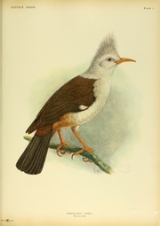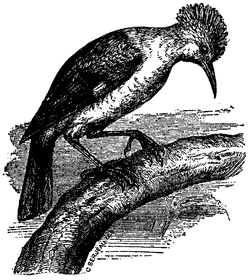
Bourbon Crested Starling
Encyclopedia
The Bourbon Crested Starling (Fregilupus varius), also known as Huppe, Crested Starling, or Réunion Starling is an extinct bird
from the family
of Sturnidae.
 The Bourbon Crested Starling was discovered in 1669 and first described 1783 by Dutch
The Bourbon Crested Starling was discovered in 1669 and first described 1783 by Dutch
naturalist
Pieter Boddaert
. It got its name from its conspicuous ash grey crest. It reached a size of 30 cm. in length. The wing
s, which were coloured grey-brown, had wingspan of 4.7 cm. The tail was 11.4 cm long and had a rufous hue. It had long yellow legs with tarsi
of about 3.9 cm. The nails were curved. The head, neck, and abdomen were white. There was sexual dimorphism
between male and female. The male had a 4 cm long light-yellow coloured bill which was slightly downcurved. The bill of the female was smaller and straight. The crest of the male was directed forwards, the crest of the female backwards. Because of its crest and the form of its bill it was long regarded as relative of the hoopoe
s by scientists, and its French name Huppe was derived from that. Boddaert named it Hupupa varia when he first described it but naturalist René-Primevère Lesson
put it in its own genus Fregilupus in 1831. However, after careful analysis of the skeletons it was reclassified as a member of the starling
family in 1874.
The Bourbon Crested Starling was endemic to the Island of La Réunion
(which was named Bourbon until the 1790s); therefore the name "Bourbon" describes the place that species lived rather than the color of its crest.
Its habitat consisted of moistly swamp forests and mountainous coastal forests. Its diet consisted of insects, grain, and fruits. Nothing is known about its reproduction—courtship, nesting habits, clutch size, incubation period, and so on.
for the purpose of combating locusts also caused a dramatic drop in the population. Human hunters then sealed its fate. Because it fed on coffee berries, and was apparently also tasty, this easy-to-hunt bird became increasingly rare during the 1830s. The last known specimen was shot in 1837.
From 1848 on, the deforestation and forest fires that followed the emancipation of the slave population resulted in severe degradation of the areas where remnant populations might have survived. Sightings of the Bourbon Crested Starling were reported as late as 1868, but none were confirmed.
As of 2006, there are 19 specimens preserved in museums (e.g. Italy, Netherlands, La Réunion, and at the American Museum of Natural History)
Bird
Birds are feathered, winged, bipedal, endothermic , egg-laying, vertebrate animals. Around 10,000 living species and 188 families makes them the most speciose class of tetrapod vertebrates. They inhabit ecosystems across the globe, from the Arctic to the Antarctic. Extant birds range in size from...
from the family
Family (biology)
In biological classification, family is* a taxonomic rank. Other well-known ranks are life, domain, kingdom, phylum, class, order, genus, and species, with family fitting between order and genus. As for the other well-known ranks, there is the option of an immediately lower rank, indicated by the...
of Sturnidae.
Description

Dutch people
The Dutch people are an ethnic group native to the Netherlands. They share a common culture and speak the Dutch language. Dutch people and their descendants are found in migrant communities worldwide, notably in Suriname, Chile, Brazil, Canada, Australia, South Africa, New Zealand, and the United...
naturalist
Natural history
Natural history is the scientific research of plants or animals, leaning more towards observational rather than experimental methods of study, and encompasses more research published in magazines than in academic journals. Grouped among the natural sciences, natural history is the systematic study...
Pieter Boddaert
Pieter Boddaert
Pieter Boddaert was a Dutch physician and naturalist.Boddaert was the son of a Middelburg jurist and poet by the same name . Pieter Jr. obtained his M.D. at the University of Utrecht in 1764 and there became a lecturer on natural history. Fourteen letters survive of his correspondence with Carl...
. It got its name from its conspicuous ash grey crest. It reached a size of 30 cm. in length. The wing
Wing
A wing is an appendage with a surface that produces lift for flight or propulsion through the atmosphere, or through another gaseous or liquid fluid...
s, which were coloured grey-brown, had wingspan of 4.7 cm. The tail was 11.4 cm long and had a rufous hue. It had long yellow legs with tarsi
Tarsus (skeleton)
In tetrapods, the tarsus is a cluster of articulating bones in each foot situated between the lower end of tibia and fibula of the lower leg and the metatarsus. In the foot the tarsus articulates with the bones of the metatarsus, which in turn articulate with the bones of the individual toes...
of about 3.9 cm. The nails were curved. The head, neck, and abdomen were white. There was sexual dimorphism
Sexual dimorphism
Sexual dimorphism is a phenotypic difference between males and females of the same species. Examples of such differences include differences in morphology, ornamentation, and behavior.-Examples:-Ornamentation / coloration:...
between male and female. The male had a 4 cm long light-yellow coloured bill which was slightly downcurved. The bill of the female was smaller and straight. The crest of the male was directed forwards, the crest of the female backwards. Because of its crest and the form of its bill it was long regarded as relative of the hoopoe
Hoopoe
The Hoopoe is a colourful bird that is found across Afro-Eurasia, notable for its distinctive 'crown' of feathers. It is the only extant species in the family Upupidae. One insular species, the Giant Hoopoe of Saint Helena, is extinct, and the Madagascar subspecies of the Hoopoe is sometimes...
s by scientists, and its French name Huppe was derived from that. Boddaert named it Hupupa varia when he first described it but naturalist René-Primevère Lesson
René-Primevère Lesson
René Primevère Lesson was a French surgeon, naturalist, ornithologist, and herpetologist.Lesson was born at Rochefort, and at the age of sixteen he entered the Naval Medical School there...
put it in its own genus Fregilupus in 1831. However, after careful analysis of the skeletons it was reclassified as a member of the starling
Starling
Starlings are small to medium-sized passerine birds in the family Sturnidae. The name "Sturnidae" comes from the Latin word for starling, sturnus. Many Asian species, particularly the larger ones, are called mynas, and many African species are known as glossy starlings because of their iridescent...
family in 1874.
The Bourbon Crested Starling was endemic to the Island of La Réunion
La Reunion
La Reunion may refer to:* La Reunion , a communal settlement near present-day Dallas, Texas*La Réunion, Lot-et-Garonne, a town in the Lot-et-Garonne department of France*Réunion, an island in the Indian Ocean east of Madagascar...
(which was named Bourbon until the 1790s); therefore the name "Bourbon" describes the place that species lived rather than the color of its crest.
Its habitat consisted of moistly swamp forests and mountainous coastal forests. Its diet consisted of insects, grain, and fruits. Nothing is known about its reproduction—courtship, nesting habits, clutch size, incubation period, and so on.
Extinction
The decline of the Bourbon Crested Starling is recorded in the letters by 19th naturalists. The main reason for its extinction was the introduction of rats, but the introduction of the Common MynaCommon Myna
The Common Myna or Indian Myna also sometimes spelled Mynah, is a member of family Sturnidae native to Asia. An omnivorous open woodland bird with a strong territorial instinct, the Myna has adapted extremely well to urban environments...
for the purpose of combating locusts also caused a dramatic drop in the population. Human hunters then sealed its fate. Because it fed on coffee berries, and was apparently also tasty, this easy-to-hunt bird became increasingly rare during the 1830s. The last known specimen was shot in 1837.
From 1848 on, the deforestation and forest fires that followed the emancipation of the slave population resulted in severe degradation of the areas where remnant populations might have survived. Sightings of the Bourbon Crested Starling were reported as late as 1868, but none were confirmed.
As of 2006, there are 19 specimens preserved in museums (e.g. Italy, Netherlands, La Réunion, and at the American Museum of Natural History)
Further reading
- Errol Fuller (2000). "Extinct Birds", ISBN 0-8160-1833-2
- Flannery, TimTim FlanneryTimothy Fridtjof Flannery is an Australian mammalogist, palaeontologist, environmentalist and global warming activist....
& Schouten, Peter (2001). A Gap in Nature: Discovering the World's Extinct Animals, Atlantic Monthly Press, New York. ISBN 0-87113-797-6. - David Day (1981). "The Doomsday Book of Animals", Ebury Press, London, ISBN 0-670-27987-0
External links
- The Auk - Myology of Fregilupus varius in relation to its systematic position (engl.)
- 300 Pearls - Information on the website of the Museum for Natural History in Amsterdam (engl.)
- American Museum of Natural History - On the anatomy and relationships of Fregilupus varius, an extinct starling from the Mascarene Islands. Bulletin of the AMNH ; v. 113, article 3 Article by Andrew John BergerAndrew John BergerAndrew John Berger was an American ornithologist from the American Museum of Natural History.Berger was born in Warren, Ohio. In 1939 he graduated from Oberlin College. After doing fieldwork in game management from 1940 to 1941, he married Edith Grace Denniston in 1942. The couple had two...
- 3D view of specimen RMNH 110.050 at NaturalisNaturalisNaturalis is the national natural history museum of the Netherlands, based in Leiden. It originated from the merger of the Rijksmuseum van Natuurlijke Historie and the Rijksmuseum van Geologie en Mineralogie in 1984. In 1986 it was decided that the museum had to become a public museum and a new...
, Leiden (requires QuickTimeQuickTimeQuickTime is an extensible proprietary multimedia framework developed by Apple Inc., capable of handling various formats of digital video, picture, sound, panoramic images, and interactivity. The classic version of QuickTime is available for Windows XP and later, as well as Mac OS X Leopard and...
browser plugin).

